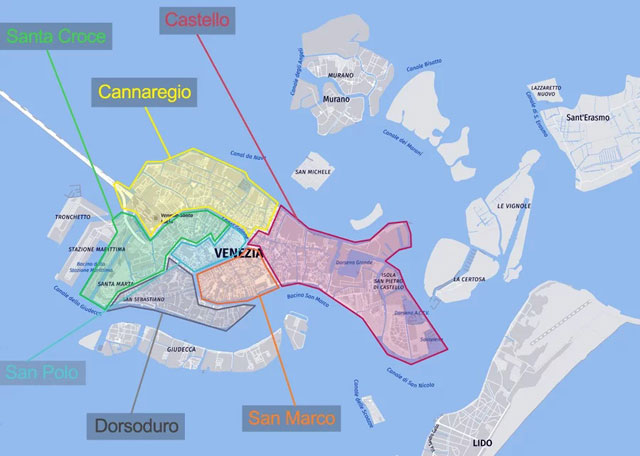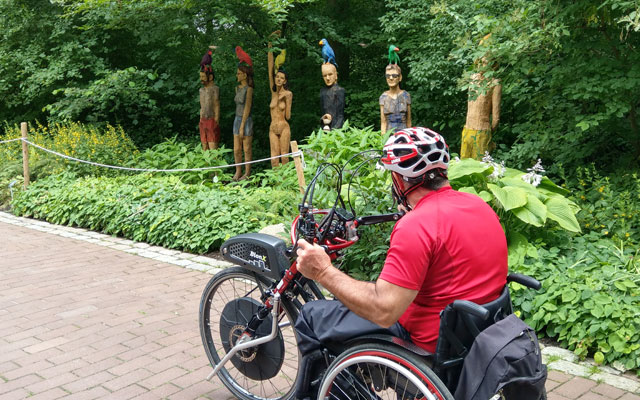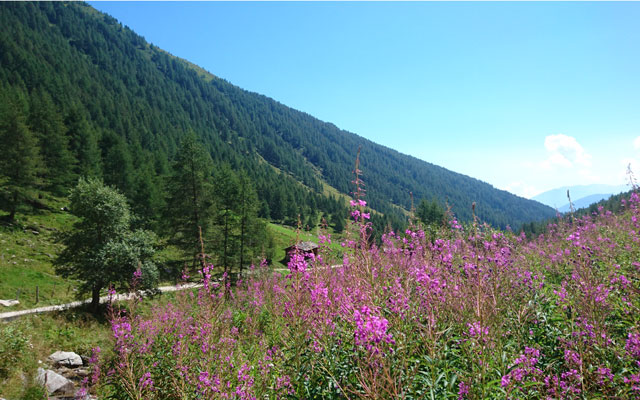Our Venice
Burano, Murano and Torcello
In this article we will deal with the islands of Murano, Burano and Torcello, which are a little further away from the main islands of the lagoon, but definitely worth a visit.

By loading the map, you accept Google's privacy policy.
Learn more

The islands of Murano and their history
Murano
Murano is a group of islands northeast of the old city of Venice. Murano is known for its Glass artbut also lives from tourism and, to a small extent, from fishing.
The roots of the archipelago reach back into the Late Antiquity back. In the 5th and 6th centuries the population grew due to refugees from Altinum seeking shelter from the Huns and Lombards. At the end of the 13th century, the focus was on glass production, which declined sharply towards the end of the Venetian Republic. Then, in the course of the 19th century, there was a revival - supported by the municipality.
Murano is located 1.1 km north of Cannaregio and about 230 meters north of the cemetery island of San Michele. The archipelago consists of 7 individual islands, which is due to 8 channels are separated from each other and 11 Bridges interconnected.
The Basilica di Santi Maria e Donato and that Glass Museum are the most important sights on the archipelago. In addition, there is the possibility in the various shops Murano Glass and works of art made of Murano glass.
Approach Murano
Murano
As explained in our first post, Venice is easy to get to.
The usual places to go are Piazzale Roma and Santa Lucia train station. From here you can take the vaporetti (water buses) towards the different parts of the city.
Murano can be reached by several water bus lines: No. 3 , No. 4. and 12.
The Line 3 is the fastest option. It is a kind of express vaporetto to Murano and departs from pier D at Piazzale Roma. The next stop is St. Lucia station and then it goes to Murano without another stop. In Murano, the water bus stops at several stops. However, the vaporetto line only runs every 20 to 30 minutes and only during the day.
The Line 4 is divided into lines 4.1 and 4.2 (sometimes called lines 41 and 42 by Venetians). The water buses of this line circumnavigate the whole main island of Venice and make a detour to the island of Murano, which they also circumnavigate once, to the island of Sant Michele cemetery and on the island of Giudecca.
It is important that the line in different directions around the islands drive:
- Line 4.1. travels counterclockwise around Venice
- Line 4.2. travels clockwise around Venice.
Depending on the stop from which you get on and where you want to go, you should therefore check beforehand whether the way is faster clockwise or anticlockwise.
Otherwise, the two water bus routes make exactly the same stops.
The circumnavigation of Venice - without detour to Murano etc. - takes about 80 minutes.
The line 12 is the "Venice Island Express" and connects the Fondamente Nove stop on the main island with Murano, Burano, Mazzorbo and Torcello. This ferry line (the boats are correspondingly larger) runs every 30 minutes. Every hour the ferry then calls at other stations on the mainland: Punta Sabbioni and Treporti. Line 12 stops in Murano only at the Faro stop.
In summary:
From the train station Santa Lucia and Piazzale Roma: Travel time about 25 minutes to 40 minutes. The fastest is line 3, otherwise about 45 minutes with line 4.2 (on the way back with line 4.1).
From San Marco (St. Mark's Square): At least 50 minutes with lines 4.1. and 4.2.
From Fondamenta Nove: About 19 minutes, but only stops at Murano Faro.
Tour: Murano Tour
Sightseeing Tip 1
If you would like to get a closer look at the fascinating art of glassblowing, there are various opportunities to take part in glassblowing demonstrations that take place in the various "fornaci" on the island. The tour proposed here covers three separate areas of the island, all of which can be reached by public transport.
Let's go.
We start at the island stop Murano Colonna and follow the street Fondamenta dei Vetrai until the church of San Pietro Martire, built in the Renaissance period. This church houses paintings by Paolo Veronese, Dominico and Jacopo Tintoretto and the "Enthroned Madonna" by Giovanni Bellini. There is barrier-free access to the church through a side door.
Palazzo da Mula
After a short detour to the church, we follow the street Fondamenta dei Vetrai a little further and reach the Venetian-Byzantine palace Palazzo da Mulawhich was built by Venetian noblemen as a summer residence and is now the seat of the municipal offices of Murano. The palace can be accessed by wheelchair via an entrance at the rear of the building. The upper floors can be reached via an elevator in the building. In the palace are also barrier-free toilets available.
Mueso del Vetro
In order to reach the second section of the tour, we take at the stop Da Mula the Vaporetto 4.2. Giracittà. The stop is directly opposite the palace. At the stop Murano Museo we leave the water bus again.
At the Murano Museo stop, we turn right onto Riva Longa street and then, at the end of Riva Longa, we turn onto Fondamenta Giustiniani. We follow the Fondamenta until Museo del Vetro, the glass museum founded in 1861 by Abbot Vincenzo Zanetti. The exhibition in the museum shows glass art products from antiquity to the present. The exhibition rooms can be reached barrier-free with the help of a lift. Also located here are barrier-free toilets.
Basilica di Santi Maria e Donato
If one follows the Fondamenta Giustiniani a little further, one reaches the Basilica di Santi Maria e Donatowhich houses a beautiful apsis mosaic with a golden background. You can also admire the beautiful mosaic floor. The side entrance of the basilica is barrier-free and all three naves can be reached via ramps inside the basilica.
Back in Campo San Donato, the large square by the Basilica, we walk along the street Fondamenta San Lorenzo and then turn left into the street Calle delle Contiere. Here we can see a marvel at a great example of industrial archaeology: the Contiere. The Conterie were a collection of old furnaces and factories for the production of colored glass beads used for necklaces, bracelets and ornaments.
Church of S. Maria degli Angeli
We follow the street Calle delle Contiere until the end and then turn right onto Campo San Bernando, follow Campo San Bernando until the street Calle Barovier. At the end of Calle Barovier turn right into Fondamenta Venier. At the end of the waterfront street is the Church of S. Maria degli Angeli, which also dates from the Renaissance. The church is currently closed to the public, but it is still worth a visit and you have a beautiful view of Murano and can Glass artwork, that were used to decorate the Fondamenta. From here we then walk back along the Fondamenta Venier to the Vaporetto stop Murano Venier.
To reach the third part of the tour, we board the bus at the Murano Venier stop or at the Murano Museo stop further down. Vaporetto line 3 or 4.2 and drive to the stop Murano Faro.
Scuola del Vetro Abate Zanetti
Opposite the Murano Faro stop, we walk along Viale Bressagio and then turn right into Calle Briati. Here is the Scuola del Vetro Abate Zanetti, the glass school of Abbot Zanetti. The school is completely barrier-free and can be booked by telephone ( +39 041 2737711) or by e-mail (info@abatezanetti.it) one can watch the glass processing. If you walk along Viale Bressagio and then turn right into Fondamenta Manin, walk along it, you will finally reach the Campo San Stefano. Where once stood the church of the same name, one finds today an oratory. In addition, from here you can see the clock tower, the Torre dell'Orologio which was built at the end of the 9th century in medieval style. From here, take the same route back to the Murano Faro stop.
From here you can either take boat no. 12 towards Burano or take the same vaporetto back towards the main islands.
Click the button below to download the content of www.komoot.de.
The Burano and Torcello archipelagos
Burano & Torcello
Burano
Burano is one of the larger islands in the Venice Lagoon, covering an area of more than 21 hectares, and one of the most densely populated, with over 2,700 inhabitants. Burano is located northeast of the historic center of Venice and consists of 4, formerly 5 single islands, which is due to 8 Bridges are connected to each other.
Burano is also known for its Lace embroiderers, who have been making lace with the intricate needlepoint technique Reticella since the 16th century.
Typical for Burano are the many small in each one to the neighboring houses contrasting bold color painted fishing houseswhich are reflected in the canals and which emphasize the individuality of the respective house owners. The curious colors attract many painters and photographers to the island. Regarding the colorful houses there is also a LegendThis tells that the colouring of the houses served the orientation of the fishermen, who identified their island and their home by the colour in the fog or after a night of drinking.
Torcello
Torcello is an island in the laguna morta, the northern part of the Venice lagoon, where the tides are no longer noticeable.
Torcello is located 150 meters north of Burano and Mazzorbo, separated from them by the Canale di Burano. The island is about 45 hectares and in 2001 lived 25 residents on the island. Torcello was already very early settledThis is evidenced, for example, by the cathedral, which dates back to the early Middle Ages. Today, Torcello is known by well-heeled gourmets mainly because of the Restaurants Locanda Cipriani a known target.
Directions to Burano and Torcello
Burano & Torcello
As explained in our first post, Venice is easy to get to.
The usual places to go are Piazzale Roma and Santa Lucia train station. From here you can take the vaporetti (water buses) towards the different parts of the city.
The islands of Burano (and Mazzorbo) and Torcello are best reached with the Ferry 12, which starts on the main island of Venice at the stop Fondamenta Nove and then goes to the islands one after the other:
Venice Fondamente Nove - Murano Faro - Mazzorbo - Torcello - Burano - Treporti - Burano - Torcello - Mazzorbo - Murano Faro - Venezia Fondamente Nove
There is only one stop on the islands of Burano and Torcello, so there is no wrong way to get off here.
Travel times:
- Fondamente Nove - Murano Faro: 19 minutes
- Fondamente Nove - Burano: about 40 - 45 minutes
- Fondamente Nove - Mazzorbo: about 23 minutes
- Fondamente Nove - Torcello: just under 40 minutes
- Murano - Burano: about 30 to 40 minutes.
Tour: Burano
Sightseeing Tip 2
On the island of Burano, a lot has been done for accessibility and thus one notices in the different places that for example the steps of the bridges have been kept low on purpose so that they can also be navigated more easily with a wheelchair.
The colourful houses and the ancient art of lace making have made Burano very famous and it is simply beautiful to drift around the island and enjoy this colourful hustle and bustle.
So take the opportunity and follow not only our tour described here, but enjoy the fascinating ambience of Burano. Let's go.
From the stop of line 12 we go straight on along Calle San Mauro. At the end of the street, turn left into Fondamenta San Mauro and follow it along the canal until you reach a level bridge over the Rio degli Assassini. Now we reach Via Baldassarre Galuppi, the main street dedicated to the 18th century composer of the island.
Church of San Martino & Lace Museum
On the main street there are many restaurants, the characteristic shops that sell lace and sweet biscuits, such as "Esse" (S-shaped biscuits) or the round "Buranei". At the end of the main street there is Piazza Galuppi, where also the Church of San Martino and the Lace Museum is located. The 16th century church houses works of art such as The Crucifixion by G.B. Tiepolo. The main entrance of the church has a step of 8 cm, which can be accessed with the help of a small ramp. The museum, which has a 10 cm step at the main entrance, is housed in the historic Lace School, founded at the end of the 19th century. The museum's exhibition rooms are accessible via ramps and a platform inside the building, and with advance booking it is possible to observe the techniques of the lace makers live.
On the island of Burano there are also two other accessible bridges, which the two smaller islands with the main island of Burano.
If you turn right from Via Baldassarre Galuppi just before the church into Rio Terrà del Pizzo, then right into Calle Pope and at the canal right into Fondamenta del Pizzo, you reach the bridge to the first island. On this is a small marina and a parkwhich invites you to linger. You can also follow the Fondamenta del Pizzo to get back to the level bridge that leads back to the stop.
The second island can be reached by turning left into Riva dei Santi street in the square in front of the church of San Martino and following it to the end. The island can now be reached via the barrier-free bridge and here you can also start a small round tour, rest in the park and watch the ships at the landing stages on the other side of the island.
Mazzorbo
From the stop of line 12 - Burano you can turn directly right and reach the island of Mazzorbo via a barrier-free bridge, which you can also explore. Here it is rather quiet and cozy, a lot of green, many parks, a few rather older houses and you can also find the cemetery of Burano.
From the stop you can now take line 12 back to the main island or cross over to Torcello with lines 9 or 12.
Tour: Torcello
Sightseeing Tip 3
Those who want to experience even more island feeling and don't feel like returning to the crowds of the main islands yet, can also visit the island of Torcello. The island of Torcello is very green and a nice change from the city. However, if you are not with a manual wheelchair and an escort, you can only visit the first part of the island.
From the stop, take the road along the canal. On the right you can see the Ponte del Diavolo, the Devil's Bridge, one of the few bridges that do not have railings.
To reach the heart of the island, a bridge with 5 steps must be overcome. The steps of the bridge are about 10 cm high, but are very deep, which is why one has good space here with the wheelchair. A manual wheelchair can be pulled up backwards by an escort. However, all other wheelchairs should not get far here.
Cathedral of Santa Maria Assunta
Crossing the bridge, one reaches a small square where there are important monuments that testify to the historical importance of the place: the Throne of Attilathe Museum of Torcello, the Church of Santa Fosca from the fourteenth century and the Cathedral of Santa Maria Assunta with the remains of the Baptistery. The cathedral was founded in the 7th century and is the oldest church in the lagoon. Inside, many Byzantine marbles and mosaics are preserved, decorating most of the floor and walls. Note in particular the magnificent Last Judgement above the main entrance. Access to the cathedral is possible by wheelchair thanks to the ramps. The Museum of Torcello, which exhibits treasures and archaeological finds, is housed in two different buildings: the Palazzo del Consiglio and the Palazzo dell'Archivio. The first houses the medieval and modern part and is accessible only on the ground floor, while the second houses the archaeological part and is not barrier-free due to a staircase.
From the stop you can either take line 9 back to Burano or line 12 back towards the main island.
Click the button below to download the content of www.komoot.de.
Next time
In the next post, you'll get tips from us on the
Zattere and Sante Margherita
So check back or better yet - subscribe to Wheelchair Tours on the social media channels!


